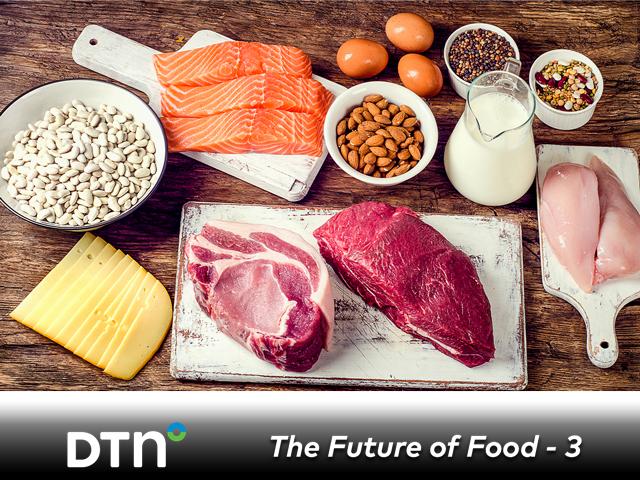The Future of Food - 3
What's on Our Future Menu?
LINCOLN, Neb. (DTN) -- As population rises, incomes go up in the developing world. Food tastes change, especially meat-consumption patterns, as demand for protein rises.
Chicken, especially, will be on the menu of the future -- and in more places.
Population growth is a major driver of increased demand, and it's projected that by 2031, the world will have 11% more people, underpinning an estimated growth of 15% in global meat consumption compared to the base period of this outlook.
In the special series "The Future of Food," DTN is looking at food insecurity but also some of the future trends, crops farmers plan to grow, technology they'll use and even new ways to grow their crops and process their animals more efficiently.
In today's story, the third in the series, we look at what foods can people expect to see on their plate in the future, especially in types and amounts of meat and proteins consumed.
USDA estimates that per capita, Americans this year are expected to eat about 223 pounds of red meat and poultry -- including beef, veal, pork, lamb, mutton -- as well as poultry, including broilers and turkey.
By 2031, that total per-capita consumption is expected to hit 227 pounds, with poultry continuing to account for most of the projected consumption at about 102 pounds per capita, an increase from about 100 pounds from 2024 through 2029.
MEAT-PRODUCTION SHIFT
The Food and Agriculture Organization (of the United Nations, FAO) outlook shows global meat supply will expand to meet rising demand during the projection period, reaching 377 million metric tons (mmt) by 2031 but growing slower than the last decade.
China is projected to account for most of the total increase in meat production, followed by the United States, Brazil and India. China will either need to produce more corn for feed or expand imports from Brazil and maybe the U.S.
By contrast, European Union meat production will fall during the outlook period influenced by increasing domestic and environmental costs, as well as reduced export opportunities because of greater competition on global markets.
P[L1] D[0x0] M[300x250] OOP[F] ADUNIT[] T[]
Globally, protein availability from poultry, pork, beef and sheep meat is projected to grow 16%, 17%, 8% and 16%, respectively, by 2031. Poultry meat is projected to constitute 47% of the protein consumed from meat sources followed by pig, sheep and bovine, FAO said.
MORE POULTRY CONSUMED
The long-term shift in meat consumption toward poultry continues to strengthen. In high-income countries, this trend is driven by a rising preference for white meats that are more convenient to prepare and are perceived as a better food choice.
USDA projects a decline in per-capita beef consumption during the next few years, with it stabilizing and gradually rising to 2031.
Americans will continue to consume beef, especially in 2023, at a per-capita rate of 55.8 pounds. That will drop off a bit by 2026 and 2027 at 55.3 pounds and rise slightly to 55.5 pounds per capita by 2031.
Although commercial beef production will grow beyond 2023, USDA expects export demand to grow more than imports. That means domestic per-capita consumption will be somewhat limited.
ALTERNATIVE PROTEINS MARKET
An analysis by the Boston Consulting Group forecasts demand for alternative meat in 2030 to be about 23 mmt. A report from Ernst and Young LLP (EY) said alternative meat will comprise about 10% of the global meat market (by value) in 2030, which corresponds to 39 mmt of alternative-meat demand, assuming price parity between plant-based and conventional meat in 2030.
Plant-based ingredients expected to lead the way include canola oil, soy protein concentrate, wheat gluten, soy protein isolate, coconut oil, sunflower oil, pea protein and cocoa butter.
But, according to Nielsen, an information, data and market measurement firm, 98% of meat-alternative buyers also purchase animal-based meat.
By 2030, the plant-based meat industry may require at least 16% of the global supply of coconut oil. By 2030, the industry will require 10 times the projected global supply of pea protein and three times the projected supply of soy protein.
According to an analysis by Ernst and Young, alternative protein penetration of the global meat market by volume will climb from less than 1% in 2020 to between 5 and 10% in 2030, and potentially much higher over the following decades.
EY says the critical drivers will be cost and quality, both of which are improving rapidly.
It's estimated that the cost of alternative protein production will likely fall below the cost of conventional protein production by the mid-2020s. By 2030, the cost of alternative protein production is expected to be less than $2.50 per pound.
**
Editor's Note:
This is the third story in "The Future of Food" series. Other articles in the series include:
"Editor's Notebook," https://www.dtnpf.com/…
"The Future of Food - 1," https://www.dtnpf.com/….
"The Future of Food - 2," https://www.dtnpf.com/…
Todd Neeley can be reached at todd.neeley@dtn.com
Follow him on Twitter @DTNeeley
(c) Copyright 2023 DTN, LLC. All rights reserved.




